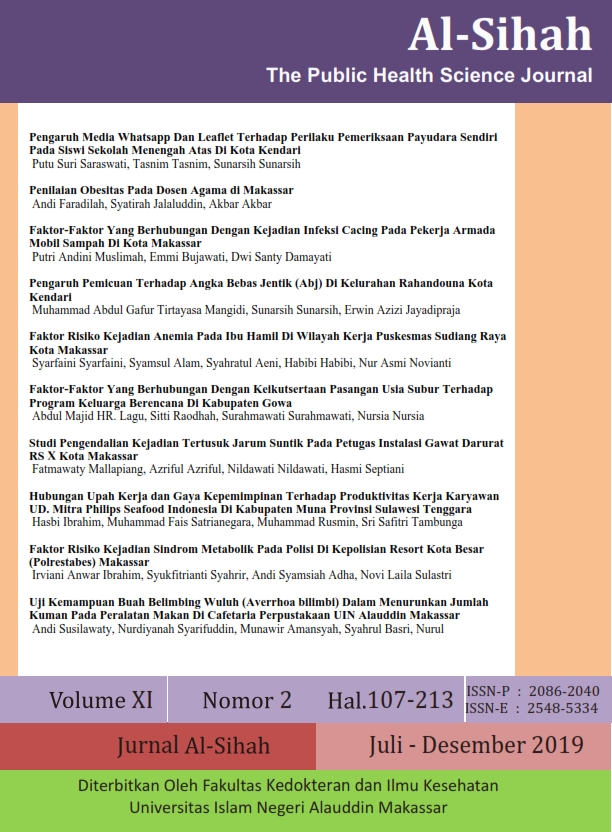Penilaian Obesitas Pada Dosen Agama di Makassar
Abstract
Obesitas telah menjadi suatu masalah didunia dengan prevalensinya yang terus meningkat. Obesitas merupakan penyebab terjadinya berbagai penyakit metabolik seperti hipertensi, penyakit jantung, penyakit ginjal, dan strok. Salah satu penyebab obesitas adalah pola makan. Nabi Muhammad telah memberikan teladan melalui hadis-hadis terhadap pola makan yang baik dan benar. Pola makan Nabi Muhammad dapat menjadi tuntunan bagi umat muslim dalam mencegah terjadinya obesitas. Penelitian ini merupakan penelitian cross sectional yang bertujuan mengukur status obesitas pada dosen agama dengan menggunakan indikator indeks massa tubuh dan lingkar perut. Sejumlah 122 subjek penelitian yang memenuhi kriteria inklusi mengisi kuisoner dan melakukan pengukuran komposisi tubuh. Penelitian ini mendapatkan prevalensi obesitas sebanyak 62% melalui pengukuran indeks massa tubuh dan 67% melalui pengukuran lingkar perut. Indeks massa tubuh dan lingkar perut sebagai alat penentuan obesitas dapat digunakan (r = 0.000, pearson’s chi square). Melalui penelitian ini dapat disimpulkan bahwa obesitas dapat terjadi pada setiap profesi termasuk para dosen agama yang merupakan panutan dalam tuntunan perilaku hidup sehat yang diajarkan oleh Nabi Muhammad.
Downloads
References
WHO. (2018). World Health Organization. Retrieved from https://www.who.int/news-room/fact-sheets/detail/obesity-and-overweight
Indonesia, D. K. (2018). Retrieved from http://www.depkes.go.id/: http://www.depkes.go.id/resources/download/info-terkini/materi_rakorpop_2018/Hasil%20Riskesdas%202018.pdf?opwvc=1
Yousif MM, K. L. (2019). Correlation Between Physical Activity, Eating Behaviour and Obesity among Sudanese Medical Students Sudan. BMC Nutrition, 1-8.
Lazarevich, C. M. (2013). Obesity, Eating Behavior and Mental Health among University Student in Mexico city . Nutricion Hospitalaria, 1892-99.
Nam, S. (2013). The Efefects of Religious Attendance and Obesity on Health by Race/Ethnicity . osong Public Health Res Perspect, 2, 81-88.
Cline KMC, F. K. (2006). Does Religion Increase the Prevalence and Incidence of Obesity in Adulthood? . J Sci Study Relig, 2, 269-281.
Kim KH, W. E. (2003). Religion and body weight. International Journal of Obesity , 469-477.
Lee MJ, P. J. (2016). Normal Body Mass Index with Central Obesity has Increased Risk of Coronary artery Calcification in Korean patient with Chronic Kidney Disease (Vol. 6). Kidney Int.
Saharkyan KR, S. V. (2015). Normal Weight Central Obesity: Implication for Total and Cardiovascular Mortality (Vol. 11). Ann Intern Med.
Deng WW, W. J. (2013). Body Mass Index Compared with Abdominal Obesity Indicators in relation to PreHypertension and Hypertension in adults: The CHPSNE study. Am J Hypertens, 1, 58-67.
Authors retain copyright and grant the journal right of first publication with the work simultaneously licensed under a Creative Commons Attribution-NonCommercial-ShareAlike 4.0 International License that allows others to share the work with an acknowledgment of the work's authorship and initial publication in this journal.
Authors are able to enter into separate, additional contractual arrangements for the non-exclusive distribution of the journal's published version of the work (e.g., post it to an institutional repository or publish it in a book), with an acknowledgment of its initial publication in this journal.
Authors are permitted to publish their work online in third parties as it can lead to wider dissemination of the work.






